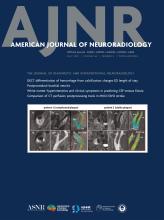This article requires a subscription to view the full text. If you have a subscription you may use the login form below to view the article. Access to this article can also be purchased.
Abstract
BACKGROUND AND PURPOSE: Rescue stent (RS) is an accepted rescue option after failed mechanical thrombectomy (MT) for acute ischemic stroke due to intracranial atherosclerotic stenosis (ICAS)–related large vessel occlusion (LVO). However, the long-term outcomes (≥12 months) of RS have not yet been elucidated.
MATERIALS AND METHODS: We retrospectively analyzed the data of 154 patients with RS for ICAS-related LVO, which were identified from a prospectively maintained multicenter database of RS after MT failure, to assess good outcome (mRS 0–2), mortality, stroke recurrence, symptomatic intracranial hemorrhage (SICH), and stent patency.
RESULTS: Among 154 patients, successful recanalization was achieved in 132 (85.7%) after RS. Clinical follow-up was available in 148 patients at 3 months, of whom 126 were followed longer than 12 months. Good outcome was observed in 53.4% (79/148) at 3 months and 53.2% (67/126) at the final assessment among survivors (median, 33; interquartile range [IQR], 13–91 months). The overall incidence of mortality was 16.2% (24/148). Mortality occurred in 8.8% (13/148) of patients at 3 months and 8.7% (11/126) thereafter, respectively. Stroke recurrence was 0.7% (1/148) within 3 months and 3.2% (4/126) thereafter. The overall incidence of SICH was 9.5% (14/148). SICH occurred in 8.8% (13/148) within the first 3 months and in 0.8% (1/126) thereafter. The stented vessel was patent in 81.1% (99/122) at the first follow-up (median, 3; IQR, 1–125 months) and 96.7% (89/92) at the final follow-up (median, 18; IQR, 13–68 months).
CONCLUSIONS: Patients with RS for ICAS-LVO showed a low stroke recurrence rate in the long-term. The long-term patency of RS appears to remain durable, particularly when it remained patent during the initial follow-up.
ABBREVIATIONS:
- AIS
- acute ischemic stroke
- DAPT
- dual antiplatelet therapy
- IA
- intra-arterial
- ICAS
- intracranial atherosclerotic stenosis
- IQR
- interquartile range
- LVO
- large vessel occlusion
- MT
- mechanical thrombectomy
- RS
- rescue stent
- SICH
- symptomatic intracranial hemorrhage
- © 2025 by American Journal of Neuroradiology












